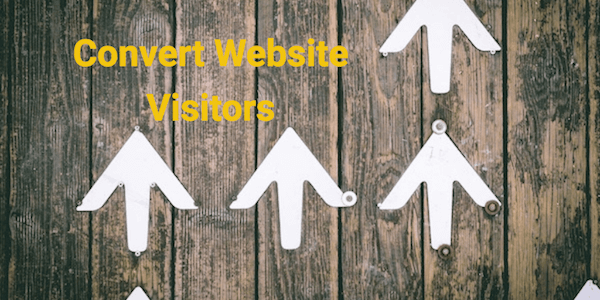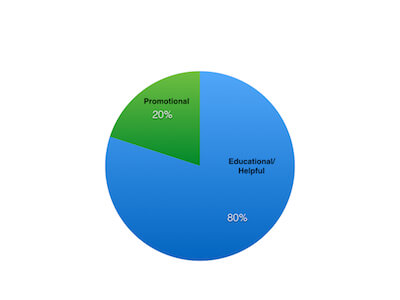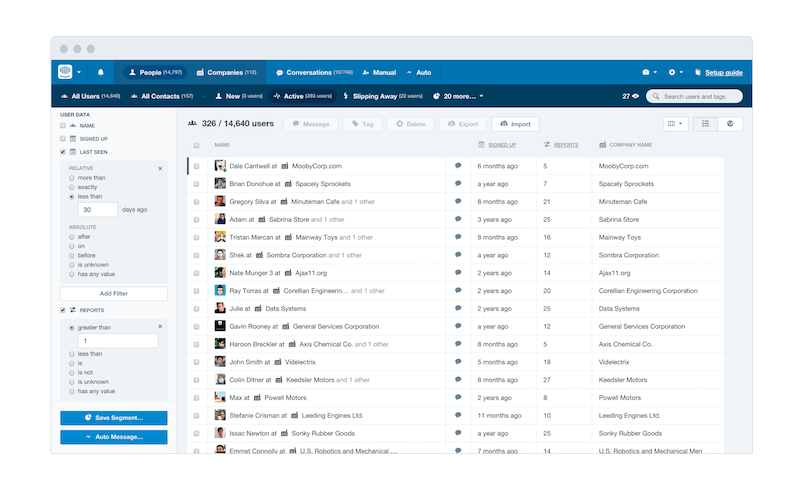“Knock knock…” Silence. Making website visitors interested enough to fill in your contact form is one of the hardest things to achieve when designing your SMB website for B2B lead generation.
When I think of B2B websites I think of a real-life scenario: a business located in the middle of nowhere.
Consider this: how will people find you if you don’t have any roads leading to your showroom, signs or lights guiding the way?
And when potential customers find you and walk in, then what? Imagine they spend considerable time looking at stuff and leave without speaking to you? Perhaps you were speaking to another customer.
Wouldn’t it frustrate you to see all these people come and go. Wouldn’t it leave you wondering who they were and what they wanted.
These same problems occur in today’s digital era when it comes to generating leads with your B2B website. Typically only 2% of website visitors leave their contact details and you’ll be left wondering, like the showroom owner: do I have what they’re looking for and will they come back?

Nowadays your whole website should be geared up for generating leads and “brochure” websites are a thing of the past. You should have different landing pages and educational blog content that through different social media and email marketing channels will serve your lead generation purposes too.
That’s why I’m going to show 5 powerful tactics you should use to turn your website into a B2B lead generation machine
1. Ditch your brochure website immediately
There’s a seismic shift going on in digital marketing as more and more businesses move from so-called “brochure” websites to website design geared towards content creation and inbound marketing, a perfect example of which is Kissmetrics’s resource-packed blog.
In fact, 76% of B2b marketers say they will produce more content in 2016 and a whopping 88% say they currently use content marketing as part of their marketing strategy (PDF).
So what does having a brochure website actually mean?
While working for online lead generation company Leadfeeder I’ve talked to plenty of decision makers who care more about how beautiful their websites are and how pictures are aligned than the value their websites provide. That’s brochure-website thinking. It serves only to state that your company exists and it barely even serves the needs of your existing customers, nevermind potential customers.
When a potential prospect visits your website they probably won’t turn into a lead if there’s not enough educational information. On these types of websites it’s often the case that there isn’t any analytics tracking, so it makes it impossible to measure ROI. A secondary problem with static-content websites like these is that Google likes fresh content, as detailed in this guide to Google’s 200 ranking factors.
You should have a website where content creation is the center of everything. Measuring, developing and keeping a strategic mindset when designing your website ensures it becomes a lead generation machine.
And by the way, it’s not the fault of your website designer if your website is not generating enough leads. You need to look at your copywriting and SEO strategy. When somebody lands on your website there should be a clear “value path” for the visitor to go on from one page to another. What I mean is that you should provide value during your visitor’s journey and that the value shouldn’t stop at any point.
This is achieved with clear and logical internal linking. For example, if a prospect lands on your features page, there should be a link to a customer success story mentioning how this feature has helped a business in real life. From there it’s a natural path to a page where the prospect can leave their contact details – the best-case scenario.
You should have calls to action (CTA), downloadable material such as e-books and forms that capture leads that are “hot” enough to leave their contact details.
Different prompts on different pages can boost the probability of turning a prospect into a lead, but only if the timing is correct. You have to think carefully about your visitor’s buying cycle and whether the CTA fits there or not.
2. Have a CTA everywhere
Having a value proposition and a call to action on your website cannot be over-emphasised, but most copywriting doesn’t achieve it – which is why, according to Sonja Simone at Copyblogger, “most copy gets weak results.”
Too many times I’ve visited a website and can’t figure out what the company is doing or providing. The website can be beautifully designed and very visual but if there’s no clear path to follow then everything can get very complex fast.
Talking of great copywriting, “Get our tips straight to your inbox, and become a better manager” is one of the best examples of a call to action. It hits you immediately: why wouldn’t you leave your email with OfficeVibe and become a better manager.
CTAs should be implemented across your entire website in different stages of the buying cycle, inspiring engagement from your website visitor. They should drive your visitors towards goal conversion and one way to make this as effective as possible is to have a benefit-oriented text, such as in the example above. According to HubSpot best practice “a couple of words is best, no more than five is ideal”.
You should have calls to action where you have most visitors, like at the end of a blog post, in sidebars and as banners and you can check which CTAs or further reading links perform best with a tool like the Page Analytics Chrome extension by Google.
CTAs should stand out with for example contrasting colours and they should be carefully chosen to match your visitor’s journey. Know the difference between lead generation CTA, lead nurturing CTA and closing CTA. All of these have different purposes. With a lead nurturing CTA you shouldn’t try to close the deal, but you should point the visitor towards a product demo or free trial.
Using your best content together with calls to action is very effective. We identified a high-performing blog post on Pipedrive and added one more CTA to the beginning of the post. It boosted conversions on that page by an astonishing 50%.
3. Use the 80/20 rule for content
What this means is that 80% of your content should be helpful to your audience and 20% should be promotional.
One of the biggest problems in building lead generation websites is not having any educational content on your site. Providing educational value upfront will help conversions and lower bounce rates as website visitors will land on pages that don’t necessarily talk about the product or service. Brochure websites have this the other way around, which kills lead generation.

Identifying your best content, re-using and promoting it over and over again in different channels is very important. Videos are becoming increasingly pivotal when talking about creating powerful content and generating leads from your website. Just check out some of these stats about video from recent research on trends.
From our own experience at Leadfeeder we know that adding a professional explainer video can offer a great return on investment. Before we added an explainer video, around 2% of our website traffic signed up for a free trial. In contrast the conversion rate among those who watch the video is 7.51% and this is just one video.

Another way of applying the 80/20 rule is for understanding how to divide time between promoting your content – for example, linking to it in a way that can help the person you’re talking to – and creating it.
It’s important to realise that once you create content you should share it over and over again, not just for driving readership but also to boost SEO. If you don’t do that and you don’t have great organic reach for your blog then your content will be forgotten.
Platforms like Inbound.org, GrowthHackers, Quora and this buzzing sales and marketing LinkedIn group by Katie Duncan are some ways to ensure your precious content doesn’t get left for dead and Brian Dean provides a comprehensive list of ways to get your content linked if you’re just getting started.
All of this takes a lot of experimentation and time: you need to find the right content for your audience and discover the best ways to share it. Know that building relationships with people who will share your content is not for fools. It takes time and serious dedication, and take note CEOs that it feels a lot more genuine if you as the author are the one doing the outreach, rather than just some guy who works for you.
Tracking and testing will help you increase your conversion rate because you’ll figure out which referral channels work well and which don’t and on top of that you need to set realistic KPIs. Content is for educating prospects, promoting your brand and helping existing users, so think twice before only measuring how many people signed up for a trial after landing on a particular blog post.
4. Concentrate on high-quality traffic
When building a lead generation website you should focus on traffic and conversion. Not all traffic is relevant so you should aim to drive traffic that is as relevant as possible and consider the possible benefits if your traffic doesn’t convert immediately.
You should identify the most valuable traffic sources; the ones that bring the most qualified prospects to your site. For example, you can determine this by bounce rate or signup conversion rate.
We’ve identified that traffic from Quora converts to trial at around twice the normal rate and by making a concerted push on Quora we’ve been able to increase our traffic even more in a very short space of time. Similarly, we identified that traffic from Google Analytics Partner Gallery was of an extremely high quality and since then we’ve been able to increase the volume of traffic.
A great tool that we use for monitoring backlinks and catching new broken links is Moz Pro. Every week we find broken backlinks that we ask to be updated so that the traffic continues to flow to us. A good backlink can result in high-converting traffic, an example of which is this mention of Leadfeeder in Entrepreneur.com From this article we got 10x more signups than from a normal referral and we’ve seen similar results from Social Media Examiner too.
Low bounce rates, a high number pages per session and how different social channels perform against one another are good ways to evaluate which traffic sources are best and where to concentrate resources.
5. Use the right tools and technologies
When building a machine, you of course need the right tech and automation toolstack. Using a content management system will make things so much easier when managing everything and I’d also recommend using live chat on your website.
We’ve increased our trial signups by 3.5 per cent with Intercom’s live chat on our website. It’s also enabled us to reach out to people who didn’t manage to complete the simple signup process so we can assist them, resulting in even more converted opportunities.

As your business grows there’s also marketing automation and account-based marketing software to consider, both of which will help you automate your lead generation machine.
Before that, you can start by using Google Analytics Network report to generate B2B leads or alternatively you can go one better and automate the process of identifying companies that visit your website and don’t contact you with Leadfeeder, which plugs into Google Analytics. These tools will complete your tracking efforts and make things so much easier, even automating lead generation all the way from your website to your CRM, like Pipedrive.
If you’re looking for keywords surrounding the primary keywords that you want to rank for then try AnswerThePublic. It’s a great free tool that allows you to answer the most relevant topics with your content and that way rank better in Google and also convert visitors more effectively.
Conclusion
Using the tactics I have outlined will help shake you out of the brochure-website way of thinking and launch you towards a website that will generate leads for your SMB.
Remember a clear value proposition and positioning across your whole website and use content and calls to actions that engage the visitor from the moment they land on your page.
Focusing on the 80/20 rule of content will help you avoid being too promotional and will earn you the right kind of blend of helpful and promotional. It will also guide you towards effective content outreach and steer you away from the flawed thinking of “publish and relax” favoured by so many people who think good content is enough.
Concentrating on driving quality traffic will help you make your lead generation as efficient as possible and with the right kind of technology you will be able to create a system that you can start justifiably calling a lead generation machine.
More leads, no forms.
Sounds too good to be true? It’s not. Identify companies already visiting your website and turn them into qualified leads to fuel your sales pipeline.
Show me how



